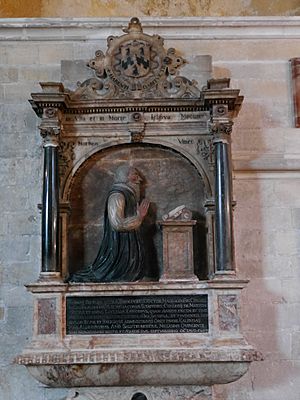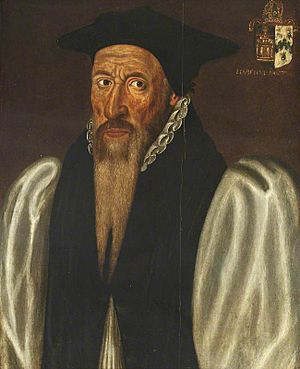Thomas Bickley facts for kids

Thomas Bickley (born 1518, died 1596) was an important English church leader. He had to leave England for a while during a difficult time for Protestants. Later, he became the head of Merton College, Oxford, and then a Bishop in the city of Chichester.
Contents
Thomas Bickley's Early Life and Education
Thomas Bickley was born in a place called Stow, Buckinghamshire. His education started when he was a young singer, known as a chorister, at the free school of Magdalen College, Oxford. He later became a "demy," which was like a student who received financial help. In 1541, he was chosen to be a Fellow of the college.
Thomas Bickley became known as someone who wanted to make changes in the church. He was also a good preacher who taught new ideas. When Edward VI became king, Thomas was chosen to be one of the king's special chaplains at Windsor Castle.
Life During Mary I's Reign
During the time when Mary I of England was queen, things were difficult for Protestants in England. Thomas Bickley decided to go to France to stay safe. He spent most of his time there studying in the cities of Paris and Orléans.
Return to England and Promotions
After Elizabeth I became queen, Thomas Bickley returned to England. His career quickly moved forward. Within ten years, he became:
- A chaplain to Archbishop Matthew Parker
- The rector (a type of priest) of Biddenden in Kent
- The rector of Sutton Waldron in Dorset
- The archdeacon of Stafford (a senior church official)
- A chancellor in Lichfield Cathedral
- The Warden (head) of Merton College, Oxford
Bishop of Chichester
In 1585, Thomas Bickley was made the Bishop of Chichester. As a bishop, he was in charge of the churches in his area. He would visit churches to check on them and make sure everything was running well. Some of his notes from these visits are still kept today.
Thomas Bickley passed away in 1596. He was buried in Chichester Cathedral on May 26th. You can find a special stone tablet in the cathedral that remembers him. It is on the north wall of the lady chapel and shows a small statue of the bishop kneeling.


